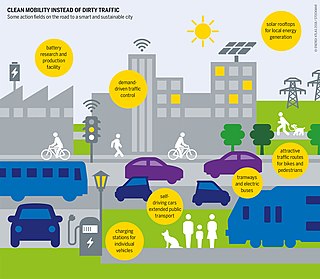
An alpha helix is a sequence of amino acids in a protein that are twisted into a coil.

In molecular biology, the collagen triple helix or type-2 helix is the main secondary structure of various types of fibrous collagen, including type I collagen. In 1954, Ramachandran & Kartha advanced a structure for the collagen triple helix on the basis of fiber diffraction data. It consists of a triple helix made of the repetitious amino acid sequence glycine-X-Y, where X and Y are frequently proline or hydroxyproline. Collagen folded into a triple helix is known as tropocollagen. Collagen triple helices are often bundled into fibrils which themselves form larger fibres, as in tendons.

The knowledge economy, or knowledge-based economy, is an economic system in which the production of goods and services is based principally on knowledge-intensive activities that contribute to advancement in technical and scientific innovation. The key element of value is the greater dependence on human capital and intellectual property as the source of innovative ideas, information, and practices. Organisations are required to capitalise on this "knowledge" in their production to stimulate and deepen the business development process. There is less reliance on physical input and natural resources. A knowledge-based economy relies on the crucial role of intangible assets within the organisations' settings in facilitating modern economic growth.
Democratic capitalism, also referred to as market democracy, is a political and economic system that integrates resource allocation by marginal productivity, with policies of resource allocation by social entitlement. The policies which characterise the system are enacted by democratic governments.
The National Innovation System is the flow of technology and information among people, enterprises and institutions which is key to the innovative process on the national level. According to innovation system theory, innovation and technology development are results of a complex set of relationships among actors in the system, which includes enterprises, universities and government research institutes.
The concept of the innovation system stresses that the flow of technology and information among people, enterprises, and institutions is key to an innovative process. It contains the interactions between the actors needed in order to turn an idea into a process, product, or service on the market.
Open innovation is a term used to promote an Information Age mindset toward innovation that runs counter to the secrecy and silo mentality of traditional corporate research labs. The benefits and driving forces behind increased openness have been noted and discussed as far back as the 1960s, especially as it pertains to interfirm cooperation in R&D. Use of the term 'open innovation' in reference to the increasing embrace of external cooperation in a complex world has been promoted in particular by Henry Chesbrough, adjunct professor and faculty director of the Center for Open Innovation of the Haas School of Business at the University of California, and Maire Tecnimont Chair of Open Innovation at Luiss.

The Social Sciences Citation Index (SSCI) is a commercial citation index product of Clarivate Analytics. It was originally developed by the Institute for Scientific Information from the Science Citation Index. The Social Sciences Citation Index is a multidisciplinary index which indexes over 3,400 journals across 58 social science disciplines – 1985 to present, and it has 122 million cited references – 1900 to present. It also includes a range of 3,500 selected items from some of the world's finest scientific and technical journals. It has a range of useful search functions such as 'cited reference searching', searching by author, subject, or title. Whilst the Social Sciences Citation Index provides extensive support in bibliographic analytics and research, a number of academic scholars have expressed criticisms relating to ideological bias and its English-dominant publishing nature.
A knowledge productionmode is a term from the sociology of science which refers to the way (scientific) knowledge is produced. So far, three modes have been conceptualized. Mode 1 production of knowledge is knowledge production motivated by scientific knowledge alone which is not primarily concerned by the applicability of its findings. Mode 1 is founded on a conceptualization of science as separated into discrete disciplines. Mode 2 was coined in 1994 in juxtaposition to Mode 1 by Michael Gibbons, Camille Limoges, Helga Nowotny, Simon Schwartzman, Peter Scott and Martin Trow. In Mode 2, multidisciplinary teams are brought together for short periods of time to work on specific problems in the real world for knowledge production in the knowledge society. Mode 2 can be explained by the way research funds are distributed among scientists and how scientists focus on obtaining these funds in terms of five basic features: knowledge produced in the context of application; transdisciplinarity; heterogeneity and organizational diversity; social accountability and reflexivity; and quality control. Subsequently, Carayannis and Campbell described a Mode 3 knowledge in 2006.

A smart city is an urban area that uses digital technology to collect data and to operate/provide services. Data can be collected from citizens, devices, buildings, cameras. Applications include traffic and transportation systems, power plants, utilities, urban forestry, water supply networks, waste disposal, criminal investigations, information systems, schools, libraries, hospitals, and other community services. The foundation of a smart city is built on the integration of people, technology, and processes, which connect and interact across sectors such as healthcare, transportation, education, and infrastructure, etc. Smart cities are characterized by the ways in which their local governments monitor, analyze, plan, and govern the city. In a smart city, the sharing of data extends to businesses, citizens and other third parties who can derive benefit from using that data. The three largest sources of spending associated with smart cities as of 2022 were visual surveillance, public transit, and outdoor lighting.

Louis André (Loet) Leydesdorff was a Dutch sociologist, cyberneticist, communication scientist and Professor in the Dynamics of Scientific Communication and Technological Innovation at the University of Amsterdam. He is known for his work in the sociology of communication and innovation, especially for his Triple helix model of innovation developed with Henry Etzkowitz in the 1990s.

The term Italy–Pakistan relations refers to bilateral relations between the Republic of Italy and the Islamic Republic of Pakistan. The nations have cordial relations.

Soumodip Sarkar is an economist and management scholar.
Science-to-business marketing entails the marketing of research conducted at research institutions, particularly universities, to industry or other interested parties. The acronym S2B follows a series of marketing acronyms used to shorten and popularise marketing specialisations, including (B2C) and (B2B).

In the fields of geometry and biochemistry, a triple helix is a set of three congruent geometrical helices with the same axis, differing by a translation along the axis. This means that each of the helices keeps the same distance from the central axis. As with a single helix, a triple helix may be characterized by its pitch, diameter, and handedness. Examples of triple helices include triplex DNA, triplex RNA, the collagen helix, and collagen-like proteins.
Industry funding of academic research in the United States is one of the two major sources of research funding in academia along with government support. Currently, private funding of research accounts for the majority of all research and development funding in the United States as of 2007 overall. Overall, Federal and Industrial sources contribute similar amounts to research, while industry funds the vast majority of development work.
The triple helix model of innovation refers to a set of interactions between academia, industry and government, to foster economic and social development, as described in concepts such as the knowledge economy and knowledge society. In innovation helical framework theory, each sector is represented by a circle (helix), with overlapping showing interactions. The initial modelling has advanced from two dimensions to show more complex interactions, for example over time. The framework was first theorized by Henry Etzkowitz and Loet Leydesdorff in the 1990s, with the publication of "The Triple Helix, University-Industry-Government Relations: A laboratory for Knowledge-Based Economic Development". Interactions between universities, industries and governments have given rise to new intermediary institutions, such as technology transfer offices and science parks, and Etzkowitz and Ledersdorff theorized the relationship between the three sectors and explained the emergence of these new hybrid organizations. The triple helix innovation framework has been widely adopted and as applied by policy makers has participated in the transformation of each sector.
Elias G. Carayannis is a Greek-American economist who is presently a full Professor of Science, Technology, Innovation and Entrepreneurship at the George Washington University School of Business in Washington, D.C.

The Fusion Industry Association is a US-registered non-profit independent trade association for the international nuclear fusion industry. It is headquartered in Washington, D.C. It was founded in 2018 to advocate for policies to accelerate the arrival of fusion power. Its CEO is Andrew Holland, former Chief Operating Officer of the American Security Project. The Fusion Industry Association has 28 members and 35 affiliate members, including nuclear reactor designers, engineering firms, suppliers, academic institutions, and various professional services with business in the nuclear fusion industry such as research consultancies. The emergence of the Fusion Industry Association can be traced back to the 2013 publication of a white paper on fusion energy by the American Security Project.












